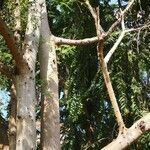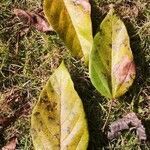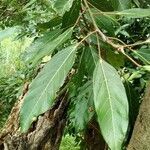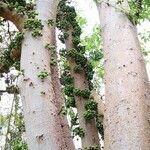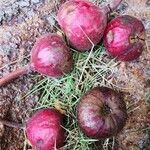Trees, 7-15 m tall, d.b.h. 10-15(-17) cm; dioecious. Bark gray to grayish brown, smooth. Branchlets green, sparsely pubescent. Stipules ovate-lanceolate, 1-1.5 cm, glabrous. Leaves alternate; petiole 2.5-6.8 cm; leaf blade broadly ovate to ovate-elliptic, 10-17 cm, thickly papery, pubescent when young, base rounded to shallowly cordate, margin entire, undulate, or shallowly toothed, apex acute, acuminate, or obtuse; basal lateral veins 4, outer 2 thin and short, secondary veins 4-16 on each side of midvein. Figs clustered on shortly tuberculate branchlets from old stem, red, with green stripes and spots when mature, globose to depressed globose, 2.5-3.5 cm in diam., apex slightly depressed and navel-like, apical pore convex, bracts ovate; peduncle 2-4 cm, slender; involucral bracts caducous, scar ringlike. Male flowers: near apical pore; calyx lobes 3 or 4, broadly ovate; stamens 2, filaments basally connate. Gall flowers: near apical pore; calyx lobes connate, tubular, apically 4-or 5-lobed; ± covering ovary; ovary enclosed by calyx lobes; style lateral, short; stigma funnelform. Female flowers: calyx lobes 3 or 4, connate at base, thinly membranous, linear lanceolate; style persistent, as long as achenes; stigma clavate, glabrous. Achenes obovoid, finely tuberculate. Fl. winter.
A fig. It is a medium sized buttressed tree up to 7-18 m high. The trunk varies in length and can be 20-30 cm across. Trees can be larger. The bark is characteristically brown and smooth. It is thick with an abundance of latex. The young shoots are pale green. The leaves are broad and oval and leathery, shiny and smooth. They are 14-20 cm long and 8-12 cm wide. The base of the leaves is rounded and heart shaped. The leaf stalks are 3 to 8 cm long and brown. The leaf like structures (stipules) at the base of the leaf stalks are 1-1.5 cm long, smooth and pinkish. Swollen structures are found along the larger limbs. Red figs with white spots are produced on the trunk and larger branches. The fruit is round and smooth and turns deep yellow when mature. The fruit are 3-4 cm across. Trees may bear thousands of fruit which are eaten by birds. Named varieties occur based on the colour of the fruit. The fruit are edible.
Tree to 20 (–30) m high; trunk to 3 m diam., with plank buttresses to 5 m high. Leaves alternate; lamina ovate to very broadly ovate, (11–) 14–25 cm long, 7.5–16 cm wide, cordate at base, sometimes sinuate-dentate margin, acuminate at apex, glabrous, smooth; lateral veins 6–8 pairs, widely spaced, arching, basal pair reaching to at least one third length of lamina; petiole 5–14 cm long, often with brown flaky epidermis; stipules to 2 cm long, green or pink. Figs cauliflorous or ramiflorous, globular to depressed-globular or obovoid to pyriform, 2–3 cm long and wide, green to reddish with spots or streaks, glabrous, densely lenticellate; ostiole slightly raised, 3–4 mm diam.; peduncle to 3–5 cm long; basal bracts 1–2 mm long. Female flowers sessile to subsessile; style subterminal; stigma truncate, glabrous.
